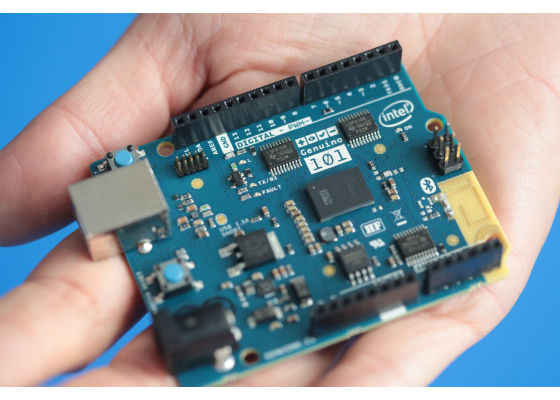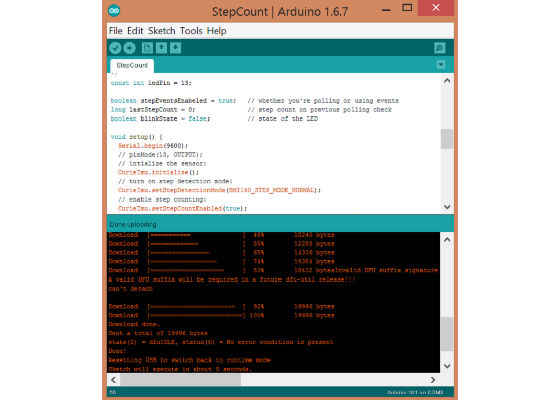Getting to Know the Arduino 101 Platform

Introduction
Depending on the requirements of the project, as an Internet of Thing (IoT) developer you need to choose the best platform to build your application. It is important to understand the capabilities of the different platforms. The first part of this article compares the Arduino 101 platform to the Arduino UNO, giving a baseline for those who aren’t familiar with the Arduino 101 features. The second part dives deeper into the capabilities of the Arduino 101* platform.
Arduino 101* and Arduino UNO* Side by Side
Arduino UNO uses an Atmel ATmega328P* module while Arduino 101 uses a low-power Intel® Curie™module powered by the Intel® Quark SE SoC. The UNO runs on 5V, while the Arduino 101 runs on 3.3 V instead of 5V, although it is 5V tolerant. The Arduino 101 has added onboard Bluetooth* low energy (LE) and a 6-axis combo sensor with accelerometer and gyroscope while the UNO does not. They are identical in size and pinout (see Figures 1 and 2).
Figure 1: Arduino 101* platform.
Figure 2: Arduino UNO* platform
Here is the summary of Arduino 101 and Arduino UNO platform features.
Arduino 101 Detailed Breakdown
Processors
The Intel Quark SE SoC contains a single core 32 MHz x86 (Intel® Quark™ processor) and the 32 MHz Argonaut RISC Core (ARC)* EM processor. The two processors operate simultaneously and share memory. The ARC processor is also referenced as the digital signal processor (DSP) sensor hub depending on what document you’re looking at. In theory, the DSP can run using a minimal amount of power, gathering and processing sensor data while the x86 processor waits in a low power mode, which would be ideal for always-on applications. However, this ability isn’t available in software at this time.
When you load an Arduino sketch, it runs on the ARC. However, the Intel® toolchain compiles your sketch so that the ARC interacts with the x86 processor as needed via static mailboxes. To experiment with that, you can access the open source corelibs for the Arduino 101 on 01.org’s GitHub*.
Real-Time Operating System (RTOS)
The standout capability for the Arduino 101 from a software standpoint is the ability to run an RTOS. Intel will be releasing a software development kit (SDK) that will include a set of software development tools, libraries, documentation, and sample code to enable developers to create IoT applications using the Intel Curie module. The SDK, based on the Zephyr Project*, will be compatible with the Arduino 101 platform and available in the coming months. Sign up to receive more information at https://software.intel.com/en-us/iot/hardware/curie.
The Zephyr Project is a small open source RTOS for the IoT. It offers connectivity protocols optimized for low-powered, small memory footprint devices and supports Bluetooth, Bluetooth LE, Wi-Fi*, and more. The RTOS keeps low memory usage and prioritizes task execution. It also provides the most efficient use of energy. The RTOS includes powerful developer tools and robust hardware features. The developer tools include custom toolchain and complier optimizations. For more information on the Zephyr project and the supported hardware features, see zephyrproject.org.
Bluetooth Low Energy (Bluetooth LE* or Bluetooth Smart*)
Arduino 101 adds onboard Bluetooth LE to enable the Arduino 101 to communicate and interact directly with several devices such as computers, smartphones, and tablets without using a Bluetooth LE shield. With Bluetooth enabled, the Arduino 101 can directly communicate with other devices without additional hardware. Bluetooth LE is ideal for low-power consumption applications. The sample code for CurieBLE is available at https://www.arduino.cc/en/Reference/CurieBLE.
Additional Libraries
Libraries are a collection of code that provide extra functionality for use in sketches. Arduino 101 libraries make it easy to connect to Bluetooth LE, sensors, and timers. To get started using the built-in Arduino 101 libraries, follow https://www.arduino.cc/en/Guide/Libraries.
- Curie BLE: Connect computers, smartphones, tablets with Bluetooth LE module
- Curie IMU: Use the on-board 6-axis accelerometer and gyroscope
- Curie TimerOne: Manage Timer functions
Accelerometer and Gyroscope
The Accelerometer and Gyroscope are the onboard sensors of the Arduino 101 platform. Accelerometers are used mainly to measure acceleration and tilt. Gyroscopes are used to measure angular velocity and orientation. These sensors provide the ability to precisely identify the orientation and movement of the object. This new feature allows the Arduino 101 platform to enable a better user experience for wearable devices.
One of the ways to use the accelerometer is to count steps, like a pedometer does. When the Arduino 101 platform makes a step motion, the step is detected. The step motion is detected when there is a significant change in velocity of the x-, y-. and z-axes relative to the resting state. For more information about the step counter, visit https://www.arduino.cc/en/Tutorial/Genuino101CurieIMUStepCounter.
Similarly to the Arduino UNO, Arduino 101 can be programmed with the Arduino IDE* software. To start using the Arduino 101, go to https://software.intel.com/en-us/articles/fun-with-the-arduino-101-genuino-101. To see how the step counting works, upload the step-counting sketch into Arduino 101 (see Figure 3).
Figure 3: Loading step-counting sketch using Arduino IDE*.
Upload the step-counting sketch (see Figure 4):
Figure 4: Running step-counting sketch on Arduino IDE*.
Move the Arduino 101 platform to make steps and view the serial monitor (see Figure 5).
Figure 5: Serial window.
Interrupt Pins
Both Arduino 101 and Arduino UNO have 20 I/O pins. Arduino 101 has more pins that can accept interrupts than Arduino UNO. Arduino UNO can trigger an interrupt on digital pins 2 and 3 while Arduino 101 can trigger interrupts on all pins. External interrupts that are triggered by external events can happen on all pins. Low value, high value, a rising or falling edge can trigger an interrupt on all pins but change value only supported by pins 2, 5, 7, 8, 10, 11, 12, and 13.
Summary
This document summarized the features of the Arduino 101. There are sensors, shields, components, and libraries that make the Arduino 101 platform more powerful. Order the Arduino 101 platform athttp://www.intel.com/buy/us/en/product/emergingtechnologies/intel-arduino-101-497161 and check outhttps://software.intel.com/en-us/articles/fun-with-the-arduino-101-genuino-101 to experiment and enjoy the power of the Intel Curie module.
For more such intel IoT resources and tools from Intel, please visit the Intel® Developer Zone.
Source : https://software.intel.com/en-us/articles/getting-to-know-the-arduino-101-platform










